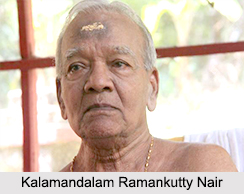 Kalamandalam Ramankutty Nair is one of the senior performers of the Kathakali form of dance. This dance personality is known for his poise and precise body movements and it is with the help of such distinguished body movements that the dance has made an acclaimed position in the field of Kathakali Dance.
Kalamandalam Ramankutty Nair is one of the senior performers of the Kathakali form of dance. This dance personality is known for his poise and precise body movements and it is with the help of such distinguished body movements that the dance has made an acclaimed position in the field of Kathakali Dance.
Ramankutty Nair is mostly popular for his anti-hero performance. He did famous performances as Ravana, Duryodhana, Keechaka and Narakasura. He had shown equal expertise in the role of Lord Hanuman and during the early days of his career he had performed as sage Parasuram where he had used semi-realistic make up and costumes. His performance as sage Parasurama had gained him a lot of fame and popularity as a Kathakali dancer.
Early life of Kalamandalam Ramankutty Nair
Ramankutty Nair was born in 1925. It was Ramankutty Nair who introduced the Ashtakalasam, the dance of happiness of Balabhadra and Krishna in the play Subhadraharanam. Ashtakalasam is a series of eight dance compositions in the Champa tala, corresponding to the Khanda jati Jhampa tala of Carnatic music.
At Kerala Kalamandalam, where he later mastered the art, Ramankutty Nair shortly sculpted out numerous disciples, the most famous among them being Kalamandalam Gopi besides Kalamandalam Vasu Pisharody, M.P.S. Namboodiri, Balasubramanian and the late K. Gopalakrishnan.
Career of Kalamandalam Ramankutty Nair
Throughout his career he was determined to stick to sheer classicism of the Kathakali Dance. From 1948 to 1985, almost every Kathakali student at Kalamandalam was trained under Ramankutty Nair. The medium built and the average facial features which he had did not make him very suitable as a romantic hero but many times he had performed as a protagonist of the play. He had performed the roles of Bhima, Arjuna and Yudhisthir which were choreographically complex in nature but the great master had delivered all his roles with absolute excellence. Some of the other well known characters which were performed by Ramankutty Nair include the role of black-bearded Kaattaalan in Nalacharitam and his Brahmana in Santanagopalam.
He was born in the year 1929 and belonged to a family which had no Kathakali lineage. But in his childhood he had come under the influence of Ravunni Menon and he mastered the art in Kerala Kalamandalam. Later on during his life when Ramanakutty had mastered the art of Kathakali Dance he had made several disciples. As a teacher, he was someone who likes to do things properly and a strong taskmaster, like his own teacher whom he revered. His very presence could suggest discipline in his students and fear in his accompanists. Till the age of 85, he performed across Kerala and polished stages in the rest of India and numerous countries of the world. In 1995, he published his autobiography, `Thiranottam`.
Awards of Kalamandalam Ramankutty Nair
Kalamandalam Ramankutty Nair was a recipient of Padma Bhushan award. He has been honoured with several awards and esteemed titles like the Central Sangeet Natak Academy Award, first State Kathakali Award and Kalidas Samman of the Government of Madhya Pradesh. He has also represented India in about all the leading theatres of the world.
Death of Kalamandalam Ramankutty Nair
Ramankutty Nair died on March 11, 2013 at age 87.



















